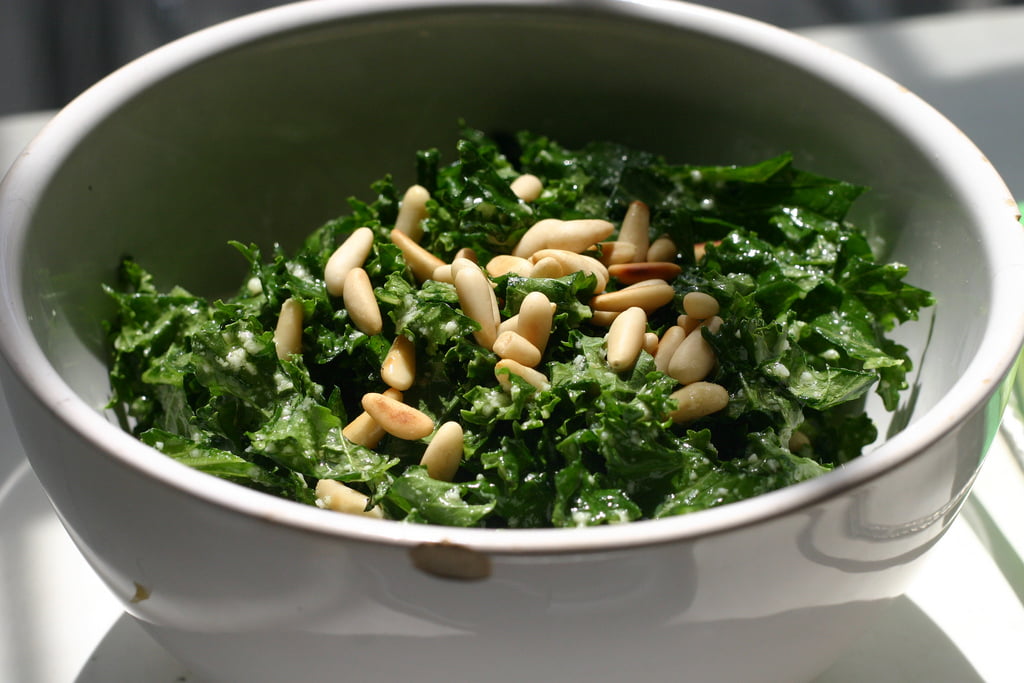
Kale is the ‘superfood’ du jour. Is kale a true superfood that leaves all others in its dust, or is it a case of hype over substance? The truth lies in a little from column A and a little from column B.
Kale is a leafy green vegetable which is part of the cruciferous vegetable family which also includes cauliflower, broccoli, cabbage, Brussels sprouts, and bok choy. As a group, the cruciferous vegetables rank near the top of any nutritionist’s list of top foods to consume so kale already has many runs on the board.
High in fibre, loaded with nutrients, and containing minimal calories, cruciferous vegetables give real bang for your nutritional buck. They’re also an excellent source of vitamin A, vitamin C, vitamin K, and calcium and a range of other chemicals called flavonoids which have antioxidant and anti-inflammatory roles in the body.
And the news gets even better because of the high amounts of potent cancer-protecting and immune-enhancing chemicals which includes sulforaphane and indole-3-carbinol found in kale, and its siblings. As a cooking tip, boiling can destroy much of the sulforaphane in kale so steaming, microwaving, or stir frying is the way to go.
It all sounds pretty good for kale and you would struggle to find a nutritionist who has anything negative to say about it. But don’t get too caught up in the hype. All of the nutritional goodness found in kale is also found in its siblings in the cruciferous vegetable family to different levels. For some, the intense and sometimes bitter taste of kale is a turn off though this has also driven the popularity of kale smoothies for a quick, easy and tasty kale fix.
The only thing to be aware of with kale that doesn’t apply as much to other cruciferous vegetables, is that it contains appreciable amounts of oxalates. Rhubarb is another food high in oxalates. When oxalate levels get too high in the body, they can crystallise and form kidney stones. Anyone with existing or untreated kidney or gallbladder problems may not want to go too crazy on eating kale.
What it all means
Much of the resurgence in eating interest in kale is warranted. The health halo of this ‘superfood’ though is not in isolation and the same potential health benefits you can get from kale, you can get from a host of other related vegetables. By all means, add some kale to your shopping trolley, but don’t let its wide leafy greens obscure your vision for the multitude of other foods you can add to your diet. There is no one true superfood, only super diets.

Sumit Kumar says
Thanks for sharing the useful information. Kale is undoubtedly one of the most nutrient-dense and healthiest foods on the planet. This green-leafy vegetable doesn’t only offer amazing health benefits, but it is also well-known for its medicinal nature. Here are the 10 incredible health benefits of kale salad. https://www.healthnwellness.in/nutrition/10-incredible-health-benefits-of-kale-salad/
Christine Houghton says
Tim, I believe that kale generates minimal amounts of Sulforaphane and indole-3-carbinol. These are the key isothiocyanates derived from broccoli. However, there is a bigger concern with kale in that it contains progoitrin, the precursor to goitrin. Goitrin prevents iodine from being incorporated into thyroid hormones. Kale and Brussels sprouts are both significantly goitrogenic. What concerns me is that the kale-juicing trend exposes individuals to far more goitrins than they would otherwise obtain. Cooking destroys the myrosinase needed to convert the progoitrins to goitrins. So my advice is to cook the kale and juice something else.
Thalia Eve says
Nice article, as always, Tim. And I agree, kale is the flavour of the month now but will soon be yesterday’s news with another superfood bandwagon arrive any second.
Tim Crowe says
Yep – it will be ‘Whatever happened to kale?’ within a year. Need to pick and promote the next ‘superfood’ before someone else does – $$$ to be made!
Tim Crowe says
That’s interesting to hear Emma and doesn’t surprise me as kale is certainly an acquired taste. Here’s my prediction: hardly anyone will be talking about kale in a year or two – I know, I’m crazy.
Emma Stirling says
Great post Tim…I am seeing a slight kale reversal coming out of our USA colleagues. Some are finding that people are adding more fat and salt to make kale palatable compared with say baby spinach in a salad or steamed broccolini.